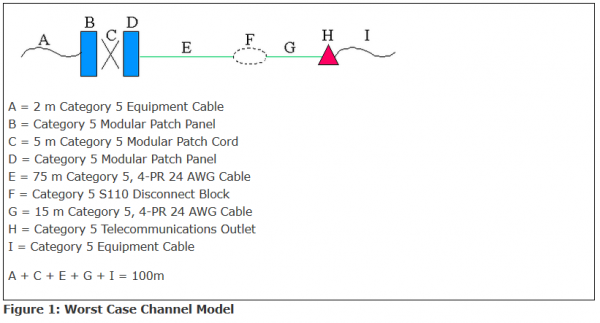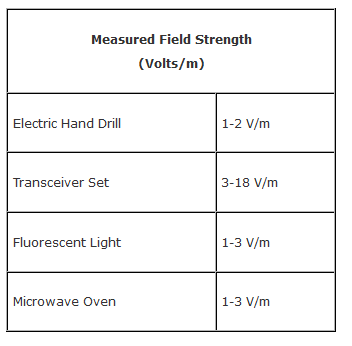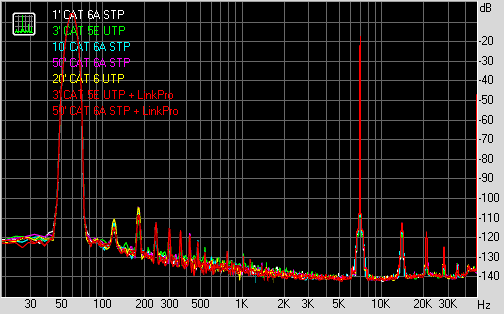Siemons has another great paper on the 'Antenna Myth':
Screened and Shielded Cabling - Noise Immunity, Grounding, and the Antenna Myth
In this paper Siemons looked at three contributors:
Differential noise (Vd): Noise induced from an adjacent twisted-pair or balanced cable
Environmental noise (Ve): Noise induced by an external electromagnetic field
Ground loop noise (Vg): Noise induced by a difference in potential between conductor ends
Environmental noise disturbers: Environmental noise is electromagnetic noise that is comprised of magnetic fields (H) generated by inductive coupling (expressed in A/m) and electric fields (E) generated by capacitive coupling (expressed in V/m).
Magnetic field coupling occurs at low frequencies (i.e. 50Hz or 60 Hz) where the balance of the cabling system is more than sufficient to ensure immunity, which means that its impact can be ignored for all types of balanced cabling. Electric fields, however, can produce common mode voltages on balanced cables depending on their frequency. The magnitude of the voltage induced can be modeled assuming that the cabling system is susceptible to interference in the same manner as a loop antenna [1]. For ease of analysis, equation (1) represents a simplified loop antenna model that is appropriate for evaluating the impact on the electric field generated due to various interfering noise source bandwidths as well as the distance relationship of the twisted-pairs to the ground plane. Note that a more detailed model, which specially includes the incidence angle of the electric fields, is required to accurately calculate actual coupled noise voltage.
Where: is the wavelength of the interfering noise source
A = the area of the loop formed by the disturbed length of the cabling conductor (l) suspended an average height (h) above the ground plane
E = the electric field intensity of the interfering source
The wavelength, , of the interfering source can range anywhere from 5,000,000m for a 60 Hz signal to shorter than 1m for RF signals in the 100 MHz and higher band. The electric field strength density varies depending upon the disturber, is dependent upon proximity to the source, and is normally reduced to null levels at a distance of .3m from the source.
The equation demonstrates that a 60 Hz signal results in an electric field disturbance that can only be measured in the thousandths of mV range, while sources operating in the MHz range can generate a fairly large electric field disturbance. For reference, 3V/m is considered to be a reasonable approximation of the average electric field present in a light industrial/ commercial environment and 10V/m is considered to be a reasonable approximation of the average electric field present in an industrial environment.
The one variable that impacts the magnitude of the voltage coupled by the electric field is the loop area, A, that is calculated by multiplying the disturbed length of the cabling (l) by the average height (h) from the ground plane. The cross-sectional view in figure 3 depicts the common mode currents that are generated by an electric field. It is these currents that induce unwanted signals on the outermost conductive element of the cabling (i.e. the conductors themselves in a UTP environment or the overall screen/shield in a screened/fully-shielded environment). What becomes readily apparent is that the common mode impedance, as determined by the distance (h) to the ground plane, is not very well controlled in UTP environments. This impedance is dependent upon factors such as distance from metallic raceways, metallic structures surrounding the pairs, the use of non-metallic raceways, and termination location. Conversely, this common mode impedance is well defined and controlled in screened/fully-shielded cabling environments since the screen and/or shield acts as the ground plane. Average approximations for (h) can range anywhere from 0.1 to 1 meter for UTP cabling, but are significantly more constrained (i.e. less than 0.001m) for screened and fully-shielded cabling.
This means that screened and fully-shielded cabling theoretically offers 100 to 1,000 times the immunity protection from electric field disturbances than UTP cabling does!
And finally:
Well balanced (i.e. category 6 and above) cables should be
immune to electromagnetic interference
up to 30 MHz.









